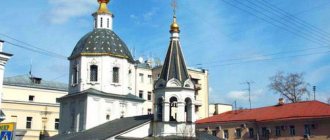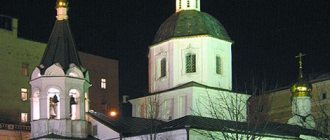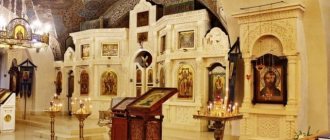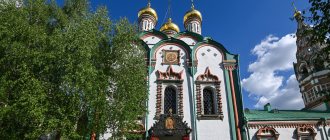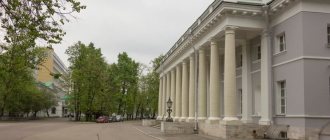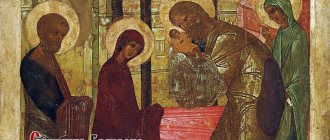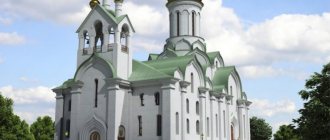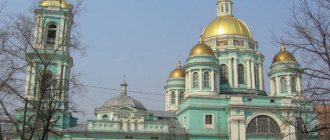Tall, visible from afar, tented temples turned out to be the most suitable in shape for construction in Rus'. Many monuments have survived to this day and still amaze tourists with their beauty. Even the area of the interior did not play a role; in the old days, tented churches were not created for large crowds of people. The sixteenth and seventeenth centuries proved to be the most fruitful for the appearance of interesting monuments. For example, St. Basil's Cathedral (Cathedral of the Intercession on the Moat) in Moscow, on Red Square, was built in 1552 and marked with its appearance the capture of Kazan. Other tented churches in Russia can hardly compete with it in beauty and fame.
Architecture
Basically, they were all built approximately the same. A stable quadrangle on which a small octagon was installed - a support for an octagonal tent directed high into the sky. Nevertheless, each architect contributed something of his own to the construction, which is why no two temples are absolutely identical. Ingenuity was most often expressed in variations of various details and in decoration.
A feature that all tented temples retain is the absence of pillars, that is, the entire structure is supported on the walls, so wide tents are practically impossible. Thus, it was for this reason that the overly wide stone tent of the cathedral of the New Jerusalem Monastery collapsed. Then it was replaced with a light wooden one and sheathed with iron, and the temple stands and pleases the people around it.
Ban?
Over the course of one century, tented churches became widespread throughout the country. But the church reform of Patriarch Nikon broke out in 1653, after which this style seemed to be banned. They stopped building tented churches in Rus'. Perhaps there was no direct ban on construction. But it’s a fact: stone tented churches were not built after Nikon’s reform. In the north, wooden tents continued to be erected on small churches, and similar bell tower completions remained popular until the advent of classicism.
Unfortunately, very few examples of wooden architecture have survived; tented wooden churches, in addition to wear and tear and post-revolutionary abandonment, suffered many hardships and almost disappeared. There are, however, protected islands in the country where antiquities are preserved. When the popularity of the Russian style returned at the end of the nineteenth century (it turned out, however, pseudo-Russian), tent architecture seemed to be revived. However, these buildings were very different from their predecessors. It turned out to be impossible to repeat the tented temples of the 17th century, especially the very first ones that appeared at the turn of the fifteenth and sixteenth centuries.
Church of the Beheading of John the Baptist in Dyakovo (Moscow region)
Multi-pillar tented temple of the 16th century. An outstanding monument of Russian architecture. Located on the territory of the Kolomenskoye Museum-Reserve, in the former village of Dyakovo, on the hill of the right bank of the Moscow River, where in the 16th century. was the royal residence. The temple is a symmetrical group of 5 octagonal pillars, isolated from each other (a pillar is a common architectural element of a vertical form; a load-bearing part of the supporting structure of buildings and structures), with independent entrances and altars. The central pillar, dedicated to the Beheading of John the Baptist, is twice as large in size as the others and is highlighted from the east by an altar apse (a lower projection of the building adjacent to the main volume, semicircular, faceted, rectangular or complicated in plan). In the center of the gallery, between two small domes facing north, there is a two-span belfry topped with a gable (the upper protruding part of the roof). In 1924-1949. the temple was closed from 1949 to 1957. Divine services were held there, but then the outstanding architectural monument remained abandoned for a long time. The church was re-consecrated in 1992, and regular services are currently held. Its large-scale restoration was recently completed.
Traditions
The appearance of hipped tops is primarily due to the fact that Russian churches were most often built as monuments dedicated to certain events. The tented temples of the 16th century were stretched upward more and more. Russian temple architecture developed precisely from changes in vaults. The hypothesis about the connection between the traditions of stone architecture and the earlier one - wooden - remained unproven and not even entirely true. This can be deduced from studies of the first buildings - the Church of the Ascension in Kolomenskoye (1532, Vasily III) and the Church of the Ascension in Vologda Posad (1493). These are the most eloquent examples of stone tented temples.
A very interesting example is the Church of the Intercession in Medvedkovo, where the architectural type with a tent instead of a dome is clearly expressed. This temple is very similar to the magnificent multi-domed St. Basil's Cathedral of the Intercession and is quite worthy of a more specific description. The most famous Russian tented churches are also very characteristic: the Intercession (formerly Trinity) Church of the Alexander Sloboda (1510), the Uglich Church “Divnaya” (1628), the Moscow Church of the Nativity of the Virgin Mary in Putinki.
Medvedkovo
This temple is built on a high basement (down there is the Znamenskaya Winter Church), which holds the entire volume of the quadrangle, the corners of which are completed with small domes. On the quadrangle there is a rather low light octagon like the base of a pointed stone tent. The proportions of the quadrangle and octagon are squat and solid, and the tent gives the structure a special slenderness and almost flight, because the height of the tent almost exceeds the entire lower part of the temple. The basement, surrounded by galleries, has two equal-sized chapels - the Nine Martyrs and Sergius of Radonezh.
By the way, for the first time in Russia, single-headed quadrangles were given a hipped roof. The altar part of the building, crowned with a special dome, has its own rare multi-stage composition due to the apsidal lower church extended to the east. Kokoshniks, placed in rows along the entire top of the walls of the quadrangle, as well as on the base of the tent and on the crowning chapter, emphasize the pyramidal structure of the building, its solemnity, aspiration to the sky and soul-elevating beauty. And from the west, the temple seems to be supported by an empire-style two-tier bell tower, rebuilt in 1840.
Saviors of the Russian Land
The troops of the talented commander M.V. Skopin-Shuisky and F.I. Sheremetev helped lift the siege of the Trinity-Sergius Lavra, which lasted almost a year and a half (1608 - 1610). The Russians could not hand over the country’s main shrine to mocking infidels for desecration. Thirty thousand Poles were opposed by only two and a half thousand defenders of Orthodoxy and Russian independence. According to legend, the Monk Sergius himself and Abbot Nikon, who replaced him after his death, appeared to the besiegers and sprinkled the walls of the stronghold with holy water. After which the Don Cossacks left the camp of Sapega and Lisovsky. And then help came.
Attempts to capture the monastery in 1618 were repulsed by troops of Lisovsky and Vladislav, who was retreating from Moscow. Realizing the futility of trying to seize the Russian throne, the proud nobles agreed to sign the Deulin Truce. Peace with Vladislav, by that time already the Polish king, was concluded only in 1634. And three years later, in the Trinity-Sergius Lavra, the tented church of St. Zosima and Savvaty of Solovetsky was built, a strict snow-white pillar rising above one of the walls of the stronghold.
It was erected in 1635-37. through the efforts of the monastery cellarer Alexander Bulatnikov (previously a monk of the Solovetsky Monastery) simultaneously with the adjacent hospital wards. Above the basement rises the only apse of the temple, around the narrow windows of which an intricate arcature-columnar pattern is drawn. It’s as if an octagon rises from the roof, decorated, like the tent, with tiled tiles depicting battle scenes - the temple is dedicated to the heroic defense of the monastery. At the base of the tent there is a belt of triangular kokoshniks, and the edges themselves are divided horizontally and vertically, and have dormer windows in the lower part. In the attached premises there are the Cathedral Chambers and chambers of the governor of the Lavra, and the Church of Zosima and Savvaty serves as his home church.
Few people know that the words of Kuzma Minin “Spare nothing, sell yards, pawn wives and children...” contained a direct meaning. Residents of the ancient merchant city on the Volga were in no hurry to shell out money. And Minin and the elected people went to the houses of wealthy townspeople, taking their families to put them up for auction. Money was immediately found, and the Fatherland was saved. Kuzma Minin did not live long after the liberation of Moscow. He died in 1616 and was buried in the parish churchyard. In 1631, the tented Archangel Cathedral was erected on the territory of the Nizhny Novgorod Kremlin.
The Archangel Michael Cathedral of Nizhny Novgorod was founded at the founding of the city in 1221 by Prince Yuri Vsevolodovich as a wooden church, and then in stone, following the example of Suzdal churches. It has fallen into disrepair over four centuries. In 1628-31. By decision of Tsar Mikhail Romanov and in memory of the salvation of the Fatherland, the cathedral was rebuilt by masters Lavrenty Semenov and Antip Konstantinov. There are no galleries surrounding the building. The cathedral is a three-apse, hipped-roofed church with three porches, above the southern of which rises a small hipped-roofed belfry. There are few decorations: the cornice of the quadrangle is surrounded by one row of ornamentation, consisting of alternating square-shaped recesses - flies. Above the cornice there are three semicircular perspective zakomaras. At the base of the tent there is a row of kokoshniks, resting on a cornice, lined with another very often used simple stone pattern - protrusions-crouts.
The ashes of Kuzma Minin rested for a long time in the Spaso-Preobrazhensky Cathedral of the city. But the cathedral was destroyed, and the ashes of the humble Savior of the Fatherland were solemnly transferred in 1962 to the Archangel Michael Church. Once Peter the Great, bowing to Minin’s grave, exclaimed; “Here is the true savior of the Fatherland!” Since then - and until the revolution itself - there was an unspoken tradition of Russian rulers visiting the hero’s burial. It was resumed many years later by President Putin, who laid flowers on the marble slab of the sarcophagus. And in 2005, a monument to Minin and Pozharsky - a smaller copy of Martos’ creation on Moscow’s Red Square. The work was carried out on behalf of grateful Muscovites by Zurab Tsereteli.
Other Russian historians did not rate the talents of Dmitry Mikhailovich Pozharsky very highly. But in vain. The prince from the Rurik family, a descendant of Yuri Dolgoruky in the 13th generation, was in public service from the age of 15, having worked his way up from the lowest positions. He faithfully served the Russian sovereigns - the Godunovs, Vasily Shuisky, and the first Romanov. At the Zemsky Sobor of 1613, which elected a new tsar, his name was also called out - he flatly refused. True to his oath, Pozharsky remained with the young tsar when the Polish troops, thirsty for revenge, led by Vladislav, approached Moscow. Yes, he could not stop Lisovsky’s raid, but still did not allow him to reach the capital; the pan-robber burned and plundered only the surrounding villages. Russia was still too weak, having just embarked on the path of revival.
After the conclusion of the long-awaited peace with the Polish-Lithuanian Commonwealth, the prince was the first to meet Metropolitan Philaret Romanov, who was returning from Polish captivity. And when Pozharsky died, Tsar Mikhail accompanied his body on its last journey with tears. The prince was buried in Suzdal - the Spaso-Evfimievsky Monastery was the traditional burial place of the Pozharsky family. The tomb of Dmitry Mikhailovich has now been restored. And not far from it stands the tent-roofed Assumption Church, erected under Vasily III, in 1525.
The Assumption Church in Suzdal is connected to the refectory chamber and, perhaps, that is why it began to be called the Assumption Refectory Church. The top of the quadrangle is decorated with semicircles drawn in the center of each wall, turning into a double belt of octagonal kokoshniks. The stone decoration is modest - the faceted apse is divided into two equal parts horizontally and divided by blades converging in a semicircle at the end of the first tier. In the niches thus formed there are small keel-shaped niches decorated with red tiles. From the east, the chapel of the martyr Diomede adjoins the temple - a high quadrangle, three rows of kokoshniks and an elegant dome on a high drum. In general, the plan of the temple somewhat echoes the Crucifixion Church-bell tower of the Alexander Sloboda. And the time of construction of these two monuments of hipped-roof architecture is approximately the same.
Medvedkovo is the ancient patrimony of the Pozharskys. It was once called differently - Medvedevo, after the first owner, Prince Vasily Medved-Pozharsky. Having made the transition from Trinity, the militia set up camp in Medvedkovo, preparing for battle. The prince, after completing his military affairs, settled in this estate of his. Of course, he did not forget the autumn of 1612 and ordered the construction of a wooden church on the site of the Russian soldiers’ camp, dedicated to the Feast of the Intercession of the Virgin Mary, for which a special bell was cast. And in 1634-35. (according to other sources - in 1640) a stone one appeared in place of the wooden temple.
The tent-roofed Church of the Intercession of the Virgin Mary stands on a high basement, in which the winter Church of the Sign is located. Divine services did not stop there throughout the Soviet era. Adjacent to the main quadrangle of the Intercession Church are the chapels of Sergius of Radonezh and the Nine Martyrs of Kizi. The unusual dedication is associated with the day of remembrance of these saints, which coincided with the date of nine days after the death of the prince. There were two more chapels, later removed. The apse of the lower church projects far to the east. At the corners of the quadrangle there are domes built on high drums, which, coupled with the elongated tent, gives the structure a special elevation. Triple kokoshnik belts adorn the top of the quadrangle and the base of the decorated tent. Like most tented churches, the Church of the Intercession was surrounded by open galleries, which later became closed. Then, in the 18th century. A bell tower was added to the temple, which was rebuilt in the middle of the 19th century.
The Pozharsky family was interrupted in 1685, and the village passed to Princess Sophia’s favorite V.V. Golitsyn. This prince began rebuilding the church, reduced the number of chapels to the current one, cast new bells, ordered an iconostasis for the main church with icons painted by the painter of the Armory, Karp Zolotarev, and presented the altar Gospel to the altar. They say that the miniatures for the sacred book were made by the hand of Princess Sophia herself. Unfortunately, the Gospel has been lost. After Golitsyn’s disgrace, the village became the property of the Naryshkins, and then changed owners several times. It is curious that the first owner of the Naryshkin family, Peter the Great’s uncle Fyodor, was married to the great-granddaughter of Prince Pozharsky.
Story
The ensuing Time of Troubles was marked by all sorts of natural disasters and interventions by the Poles and Swedes, so the state, political and economic situation of the state was extremely difficult. Tent churches in Moscow, and throughout the country, have practically stopped being built. Stone construction as such ceased altogether. Only twenty-five years later Russia reached a sufficient level for the resumption of stone architecture. Basically, after 1620, temples repeated previous types of buildings.
And very soon the reform of Patriarch Nikon followed, when the tented churches ceased to “correspond to the rank.” Nikon liked domes with three or five domes. In 1655, during the construction of the temple in Veshnyaki, by order of the patriarch, two aisles were completed not with pointed domes, but with round domes, although the project provided for the first.
Pillarity as a forerunner
Here, first of all, during the church reform, the rejection of everything old and the patriarch’s preference for everything Byzantine, including cross-dome structures, were in effect. While the tented churches in Rus' were more reminiscent of Western European Gothic: dynamics, upward thrust, tower architecture of pillar-shaped churches.
For example, the Church of John the Baptist in the village of Dyakovo (Moscow) and the Church of the Transfiguration of the Lord in the village of Ostrov (Moscow region). Both were built in the second half of the sixteenth century, both are pillar-shaped and predate the tent-type buildings. Another example is one of the most famous bell-tower churches “Ivan the Great”, built in honor of John Climacus on the territory of the Kremlin in 1505.
Church of the Ascension (Kolomenskoye)
This temple is a masterpiece of world architecture, the first stone tented temple in Russia. The church was erected in 1528-1532. presumably by the Italian architect Peter Francis Anibale (Peter Fryazin, or Petrok the Small) on the initiative of the Grand Duke of Moscow Vasily III. It is believed that the construction of the temple was connected with the birth of Vasily III's long-awaited heir - the future Ivan the Terrible. Although not all data indicate this. Perhaps the temple was erected to pray for the childbirth of the grand ducal couple. The original decoration of the church interior has not been preserved. There is no information about interior painting. In the tented temple, wall pylons made it possible to build a huge building of large proportions, with “flying” architectonics. In the history of Russian architecture, the temple remained a perfect work, one and only. The church is built of brick with numerous white stone decorative elements in the form of a centric temple-tower; its height is 62 m. The plan represents an equal-ended cross. The interior space of the temple is just over 100 m². Around the temple there is a two-tier gallery with three high staircases. The temple is covered with a tent with clearly defined ribs. The building uses numerous "Renaissance" and Gothic elements. The church building is part of the Kolomenskoye museum-reserve complex. Since 1994 it has been a UNESCO World Heritage Site. Another remarkable monument of tented architecture of the 16th century. – white stone Church of the Transfiguration in the village of Ostrov.
Examples
The function of the bell tower with a tier of bell towers built directly above the temple does not correspond to the purpose of tent churches. There were many different architectural solutions in use here, enormous freedom for the architect, and yet the result was almost always small pillar-shaped temples.
For example, the Church of the Descent of the Holy Spirit (1476, Trinity-Sergius Lavra), the Kolomna St. George Bell Tower (formerly the Church of the Archangel Gabriel, 1530), the Church of Simeon the Stylites (Danilovsky Monastery, Moscow, 1732, built over the Holy Gate), two also the gates of the temple in the Donskoy Monastery, the temple of St. Sergius of Radonezh (Novospassky Monastery, bell tower), the temple of Theodore Stratelates the Holy Warrior (Menshikov Tower, Moscow, nineteenth century) and some others.
Symbols
Stone hipped architecture is similar in form to wooden one; this style has been widespread from hoary antiquity to the present day. It appeared, judging by the chronicles, clearly from wooden samples. However, if for structural reasons the dome was replaced by a tent during the construction of wooden temples, then stone construction cannot in any way be connected with the structure. Rather, it was a desire to convey a certain image - festivity, upward striving. Not only in the provinces, but also in the capital, the elongated silhouettes of wooden churches were the most desirable and always played a leading role.
Tent architecture contains the deepest semantic load: it is both the path to the Kingdom of Heaven and the connection of a square (the created world) with a circle (a symbol of eternity). The quadrangle is a square symbolizing the earth, the octagon is all the directions of space along the cardinal points, plus an eight-pointed star as a symbol of the Virgin Mary, and the eighth day is the sacred number of the century of the future. The tent crowning the temple is a cone, an image of the ladder of the Forefather Jacob, the path to God.
Tent architecture
Tent temples, despite their grandiose external component, also carried a deep semantic load. The symbolic meanings of temples are conceptualized and understood by scientists in different ways. For example, it is believed that the tented temple represents an architectural model of the path to the Heavenly Kingdom and is the junction of the earthly square (symbol of the created world) with the heavenly circle (symbol of eternity).
| Intercession Cathedral on Red Square in Moscow |
The tradition of erecting monuments dates back to ancient times. Ancient Greek and Roman cities were decorated with numerous statues of outstanding rulers and generals, triumphal arches reminiscent of glorious victories, and ceremonial columns. In Ancient Rus', specially erected crosses, chapels and, in special cases, temples served as monuments. Most often, the construction of temple-monuments was associated with military victories. Thus, in memory of the victory over the Tatar-Mongols on the Kulikovo Field (1380), the Church of the Nativity of the Virgin Mary was built in the Bobrenevsky Monastery near Kolomna. The famous Intercession Cathedral on Red Square in Moscow, better known as St. Basil's Cathedral, was erected by order of Ivan the Terrible in honor of the victory of Russian regiments over the Kazan Khanate in 1552. However, not only military victories were celebrated with the construction of monument churches. There were other events that seemed to contemporaries worthy of immortalization in brick and stone. One of the happiest and long-awaited days in the life of the Moscow sovereign Vasily III came on August 25, 1530. The Tsar rejoiced not just as a father who saw his first-born, but also as the ruler of a huge troubled country, who understood that if he did not leave an heir, then after him After death, unrest and civil strife will begin again in the Russian lands, and the building of a unified state, created with such difficulty by his father Ivan III, will give dangerous cracks. And Vasily Ivanovich had to wait a long time for an heir - as much as 25 years. His first wife, childless Solomonia Saburova, languished in a monastery. And the second, Elena Glinskaya, did not immediately give him an heir. When, finally, the son was born, bells rang in Moscow, people in churches fervently prayed for the health of the newborn prince. Vasily III made a pious vow: to build a wooden monument church in the name of the heavenly patron of his long-awaited son, St. John the Baptist. Exactly a year later, in August 1531, in the Old Vagankovo tract, not far from the Kremlin, the temple promised to God was erected.
| Temple of the Ascension in Kolomenskoye |
There is also another monument associated with the birth of Ivan IV - the famous Church of the Ascension in the grand-ducal village of Kolomenskoye near Moscow. It was consecrated on September 3, 1532, on the eve of the day on which the heir of Vasily III was baptized two years earlier. With its amazing beauty and unusual proportions, the new church captured the imagination of its contemporaries. The chronicler enthusiastically noted that such a “great” church “has never happened before in Rus'.” Indeed, the temple in Kolomenskoye opened a new page in the history of medieval Russian architecture. On the steep bank of the Moscow River, a huge white stone pillar rose upward. Its powerful base grows from an intricacy of galleries that seem to float above the ground. The multifaceted pointed base of the temple ends with triple pointed kokoshniks, reminiscent of tongues of frozen flame. And above them, on a slender octagonal base, rises a tent, crowning the entire building. The edges of the tent are intertwined with narrow stone garlands, similar to strings of precious pearls. Its top is covered with a small neat cupola with a gilded cross sparkling in the sun. The symbolism of the new temple was obvious. His whole appearance, majestic and solemn, spoke of two events: heavenly - about the Ascension of the Son of God to the Father, to the throne of the King of Kings, and earthly - about the birth of the heir to the throne of the Moscow state. The main thing that distinguished the temple in Kolomenskoye from all Russian churches that preceded it was the stone (brick) tent. Before that, all Russian churches were completed with vaults and crowning domes (domes on drums). The bell towers were also crowned with domes. True, the vaults of many cathedrals in the 15th century. they stretched upward more and more, but not a single architect thought of replacing them with a high tent.
| Church in the name of Metropolitan Peter in Pereslavl Zalessky |
In the 50s–60s.
XVI century Memorial tented churches were erected in Balakhna, Murom, Kolomna, Staritsa and other places. A high, elegant tent covered the central volume of the main temple-monument in the entire Moscow state - the Intercession Cathedral on Red Square in Moscow (1555–1560), built in honor of the capture of Kazan in 1552. In just two decades that passed after the appearance of the first stone tent temple in Kolomenskoye, this new type of architecture was recognized by Russian architects, who began to erect tented churches in many cities and villages on a par with the more familiar ones - those covered with a vault. Almost all tented churches of the 16th century. had the same composition: on the lower cubic part (quadrangle), which served as the base, an octagonal pillar (octagon) was built, which crowned the tent. However, the architects, accepting this general scheme, achieved extraordinary diversity, and not a single tented temple repeated the other. Tent temples, despite their grandiose external component, also carried a deep semantic load. The symbolic meanings of temples are conceptualized and understood by scientists in different ways. For example, it is believed that the tented temple represents an architectural model of the path to the Heavenly Kingdom and is the junction of the earthly square (symbol of the created world) with the heavenly circle (symbol of eternity). In the tented temple, the square of the quadrangle is a symbol of the Earth (as in the pyramid). The octagon on a quadrangle is the universal number of directions of space, but it is also an eight-pointed star, a symbol of the Mother of God and the sacred number of the future century - “the eighth day.” And the tent crowning the temple is the heavenly cone of the path to God, the place of connection between the earthly and the heavenly.
Each tent had its own silhouette, and additional decorations and extensions further emphasized the originality of this or that monument. Thus, the master, who built in the second half of the 16th century. The Church of the Transfiguration in the village of Ostrov near Moscow was decorated with its tent with several rows of “foaming” kokoshniks, the number of which is 144. In the church in the name of Metropolitan Peter in Pereslavl Zalessky (1585), the tent is clearly separated from the powerful wide base of the building. In 1603, by order of Tsar Boris Godunov, the largest tented church in the name of Saints Boris and Gleb was built in the Borisov town near Mozhaisk. It was 9 meters higher than the temple in Kolomenskoye and reached 74 meters.
| Church of the Nativity of the Virgin Mary in Putinki |
XVII century brought with him new artistic trends. The architecture became more and more elegant, churches sometimes resembled fairy-tale towers, the walls of buildings were decorated with tiles and painted with bright colors. The tent-roofed architecture did not remain unchanged. Often, the tent turned from the main ceiling into a decorative detail of the completion and therefore lost connection with the internal space of the structure. Sometimes it no longer crowned the entire volume, but only part of it, or even replaced church domes. In 1649–1652 In Moscow, the Church of the Nativity of the Virgin Mary was built in Putinki. Its rich decoration included four decorative tents placed on narrow elegant drums, which in turn rested on the vaults. This church was no longer literally a tented church, since the tents were used by architects only to decorate the building. However, it is famous for the fact that it became the last monument of hipped-roof architecture in Moscow. In 1652, Patriarch Nikon ordered from now on that churches should “be built with one, three, or five chapters, and not build tent churches at all.” According to scientists, this ban was justified for several reasons: firstly, the implementation of church reform and, accordingly, the rejection of “everything old”, and secondly, the desire of the patriarch to get closer to the Byzantine model. Subsequently, the ban was confirmed, and the architects pointed to the five-domed Assumption Cathedral of the Moscow Kremlin as an example.
| New Jerusalem Monastery |
Nikon himself was perhaps the first to break his ban, planning to build a temple that would repeat the shape of the main Christian shrine - the Church of the Resurrection in Jerusalem.
The Patriarch ordered the construction of a stone tent of unprecedented size over the rotunda adjacent to the Church of the Resurrection in the Resurrection New Jerusalem Monastery he founded near Moscow. The tent was so large that for no apparent reason it collapsed in 1723. In 1748, they began to restore it according to Rastrelli’s design, but from wood. After the ban, tented churches also appeared in the provinces. However, Moscow architects could no longer afford such freedom and subsequently used their favorite tent only to complete the bell towers.
Tent architecture of the 16th–17th centuries, which draws its origins from traditional Russian wooden architecture, is a unique direction of Russian architecture, which has no analogues in the art of other countries and peoples. The tented churches of the Moscow State are Russia’s unique contribution to world culture.
Candidate of Theology, Head of the Department of Church History at Sretensky Theological Seminary
Kolomenskoye and Alexandrovskaya Sloboda
Trinity Church of Alexander Sloboda (now Pokrovskaya) is the palace temple of Prince Vasily III. There has long been controversy regarding the date of construction, but recent research places it at 1510. Before this, the very first tented church was considered the Ascension in Kolomenskoye (1532), which was also built by the same Grand Duke.
It is certainly the greatest masterpiece, but it was not the first. Both churches were built in the sovereign's estates as small courtiers. Moreover, Voznesenskaya became a monument in honor of the birth of the heir - the great Ivan the Terrible. The creator of the amazing ensemble in Alexandrovskaya Sloboda is considered to be an architect from Italy - Aleviz Novy; the author of the Church of the Ascension is supposedly also an Italian - Petrok Maloy.
Church of the Transfiguration in the village of Ostrov (Moscow region)
This temple is the courtyard of the Patriarch of Moscow and All Rus'. The exact date of construction of the church building has not been established; it dates back to the era of Ivan the Terrible. In the 19th century a bell tower was built in a pseudo-Gothic style. The temple has been open as a functioning church since 1992. It belongs to the tented churches, built of limestone, height about 40 m. The base of the church, cross-shaped in plan, bears an octagonal figure, completed by a smooth tent. The transition points from the base to the octagon and from the octagon to the tent are decorated with tiers of kokoshniks. The cross pillar is decorated with 12 domes. On the sides of the pillar there are two identical chapels in the Pskov style. A covered gallery, built in the first third of the 19th century, surrounds the temple from the north, west and south.
In 1830, a bell tower in pseudo-Gothic style was added to the church. In the late 1990s, a chapel of St. Seraphim of Sarov was erected nearby, and in the summer of 1999, a second chapel of St. Nicholas the Wonderworker with a wooden sculpture of the saint was erected.
St Basil's Church
Since this is the main attraction not only of Moscow, but of the whole country, this tented temple needs to be described in as much detail as possible. The Kazan Khanate was defeated, and in honor of this a monument was created, which to this day is a symbol of Russia and an unsurpassed architectural monument. The Cathedral of the Intercession on the Moat took six years to build (since 1555) and turned out to be unusually, even not earthly, beautiful. Previously, there was a Trinity Church and a defensive ditch along the entire Kremlin, which was filled in only in 1813. In its place is now a necropolis and a Mausoleum.
Who is St. Basil, buried right next to the Trinity Church on Red Square? This is a Moscow holy fool, endowed with the gift of clairvoyance, who predicted many disasters, including the huge fire of 1547, when almost all of Moscow burned down. Ivan the Terrible himself revered and was quite afraid of St. Basil, which is why they buried him with honors and in the reddest place. Moreover, a temple was soon founded nearby, where the relics of the holy fool were later transferred, since real miracles began at his grave immediately after the funeral - people were healed, received their sight, the lame began to walk, and the paralyzed stood up.
Out of eight wins
The Kazan campaign began, which for the first time ended in victory; usually the Russians in this direction suffered failure after failure. Ivan the Terrible made a vow - if Kazan falls, to build the most grandiose temple on Red Square as a memory of the victory. And he completely fulfilled his promise.
The war was long, and in honor of each victory of Russian weapons, a small church was built next to the Trinity Church in honor of the saint whose day its victory coincided. After his triumphant return, Ivan the Terrible, instead of eight new wooden churches, decided to erect one large stone one - the most famous one, so that it would last for many centuries.
Looking for a solution
The restoration of the independence of the Russian state and the awareness of the inevitability of autocracy as a guarantee of non-return to civil strife among the princes and a new collapse was accompanied by growing interest in the pre-Mongol period of history, the times of Vladimir the Red Sun and the epic heroes, to whom tower-like temples became unique monuments. Unlike, say, Kyiv and Smolensk, they were decorated with keel-shaped zakomaras, rows of kokoshniks that transferred the load from high drums to the walls and onion-shaped domes that were not afraid of snow loads and excessive moisture from melt water.
Now the chapter does not depend on the design of the dome end, but can stand on a blind drum or cylindrical pedestal, resting on walls or vaults. Tower-shaped churches (such as the Spassky Cathedral of the Andronikov Monastery in Moscow or the Assumption Cathedral in Kolomna) could not accommodate a large number of parishioners. Along with them, following the Vladimir-Suzdal tradition, they built cross-domed cathedrals, changing the location of the pillars: they moved their eastern pair and the very head to the apses, which can be seen in the architectural masterpieces of Zvenigorod. At the same time, the drum itself was raised above the belt of kokoshniks, which we do not see in the pre-Mongol churches of Vladimir-Suzdal Rus'.
At the beginning of the 16th century. In Russian cities, whose population is growing faster than villages depopulated after wars and raids, small stone townsman churches are being built, for which the four-pillar design, which cramps the already small internal space, turned out to be unprofitable. Pillarless coverings were installed here, when intersecting pairs of arches rested on the walls, and a drum with a dome was installed at the intersection. The vaults between the parallel arches also created a symbolic cross. Such churches had from one to three apses, and the internal walls were connected by an iconostasis. In rural parish churches, the constructive solution was even simpler - the dome was strengthened above the ridge of the gable roof, a simple belfry was installed nearby (Stefanievskaya Church in Kideksha, near Suzdal).
Wooden cage churches, tower-shaped and pillarless stone churches with towering pyramids of kokoshniks seem to have prepared the appearance of unique - there is no other way to say it - religious buildings in Russian architecture. We are talking about tented pillarless temples.
Legends
The builders of the beautiful temple earned such an abundance of a wide variety of stories that it is simply not possible to bring everything here. Traditionally it was believed that Tsar Ivan the Terrible hired two craftsmen: Barma and Postnik Yakovlev. In fact, there was only one person - Ivan Yakovlevich, whose last name was Barma, and whose nickname was Postnik. There is a legend that after construction, the sovereign blinded the architects so that they would never again build anything more beautiful than this temple. So many works of art have been written based on this fairy tale! However, this is not true either.
There are documents, and quite a large number of them, that after the Cathedral of the Intercession this Faster built the Kazan Kremlin. It could have been more beautiful, probably, but nowhere. Of course, not like St. Basil's Cathedral, which is unique, but also a great work of architecture. In addition, it is the hand of the Faster that is felt in the construction of the Annunciation Cathedral (Moscow Kremlin), the Assumption Cathedral, St. Nicholas Church (Sviyazhsk - both), even the Church of John the Baptist in Dyakovo. All these temples were created much later.
